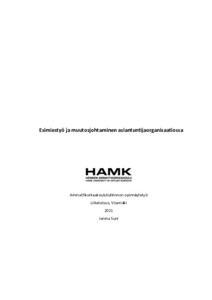Esimiestyö ja muutosjohtaminen asiantuntijaorganisaatiossa
Suni, Janina (2021)
Suni, Janina
2021
All rights reserved. This publication is copyrighted. You may download, display and print it for Your own personal use. Commercial use is prohibited.
Julkaisun pysyvä osoite on
https://urn.fi/URN:NBN:fi:amk-2021120924848
https://urn.fi/URN:NBN:fi:amk-2021120924848
Tiivistelmä
Tämän opinnäytetyön tavoitteena oli selvittää minkälainen rooli ja vastuu esimiehellä on muutoksessa, sekä mitä esimiehen tulisi huomioida muutoksessa Leanin näkökulmasta. Työtä lähdettiin tekemään asiantuntijaorganisaatiossa tapahtuvan esimiestyön näkökulmasta, joka samalla toimi rajauksena työn aiheelle.
Keskeisimpinä teemoina työssä ovat esimiestyö, muutosjohtaminen sekä Lean. Teoreettisessa viitekehyksessä käsitellään esimiehen työtä sekä roolia, muutosjohtamista ja sen haasteita sekä Lean-johtamista ja sen tärkeimpiä työkaluja. Tutkimus toteutettiin laadullisena kyselytutkimuksena, joka rakennettiin työssä käsitellyn teorian pohjalta.
Tutkimuksessa saatujen tulosten perusteella esimiehen roolina muutosjohtamisessa on tukea sekä rohkaista työntekijöitä. Esimiehen vastuuna on taata oikeanlainen ja oikea aikainen viestintä sekä suunnitelmallinen muutoksen läpi vienti koko prosessin ajan. Esimiehen läsnäolo koetaan tärkeäksi, mutta liian suurta tai vähättelevää roolia esimiehen ei tulisi kuitenkaan ottaa. Esimiehen ollessa avoin ja osallistava voidaan laskea muutosvastarinnan määrää työntekijöiden keskuudessa. The aim of this thesis was to find out what kind of role and responsibility the supervisor has in the change management, as well as what the supervisor should notice in change from Lean's point of view. The work was started from the perspective of the work of the supervisor in the expert organization, which at the same time served as a delimitation to the topic of the work.
The most important themes in the work are supervisory work, change management and Lean. The theory section processed work and role of a supervisor, change management and its challenges, and Lean management and its key tools. The research was carried out as a qualitative survey, which was built based on the theoretical knowledge discussed in work.
Based on the results of the study, the role of the supervisor in change management is to support and encourage employees. It is the responsibility of the supervisor to ensure proper and timely communication as well as planned export through change throughout the process. The presence of a supervisor is perceived as important, but the role of the supervisor should not be too big or dismissive. When the supervisor is open and participatory, the amount of change resistance among employees can be estimated.
Keskeisimpinä teemoina työssä ovat esimiestyö, muutosjohtaminen sekä Lean. Teoreettisessa viitekehyksessä käsitellään esimiehen työtä sekä roolia, muutosjohtamista ja sen haasteita sekä Lean-johtamista ja sen tärkeimpiä työkaluja. Tutkimus toteutettiin laadullisena kyselytutkimuksena, joka rakennettiin työssä käsitellyn teorian pohjalta.
Tutkimuksessa saatujen tulosten perusteella esimiehen roolina muutosjohtamisessa on tukea sekä rohkaista työntekijöitä. Esimiehen vastuuna on taata oikeanlainen ja oikea aikainen viestintä sekä suunnitelmallinen muutoksen läpi vienti koko prosessin ajan. Esimiehen läsnäolo koetaan tärkeäksi, mutta liian suurta tai vähättelevää roolia esimiehen ei tulisi kuitenkaan ottaa. Esimiehen ollessa avoin ja osallistava voidaan laskea muutosvastarinnan määrää työntekijöiden keskuudessa.
The most important themes in the work are supervisory work, change management and Lean. The theory section processed work and role of a supervisor, change management and its challenges, and Lean management and its key tools. The research was carried out as a qualitative survey, which was built based on the theoretical knowledge discussed in work.
Based on the results of the study, the role of the supervisor in change management is to support and encourage employees. It is the responsibility of the supervisor to ensure proper and timely communication as well as planned export through change throughout the process. The presence of a supervisor is perceived as important, but the role of the supervisor should not be too big or dismissive. When the supervisor is open and participatory, the amount of change resistance among employees can be estimated.
